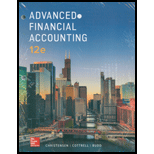
ADVANCED FINANCIAL ACCT.(LL) >CUSTOM<
12th Edition
ISBN: 9781260824292
Author: Christensen
Publisher: MCGRAW-HILL HIGHER EDUCATION
expand_more
expand_more
format_list_bulleted
Question
Chapter 3, Problem 3.2.4E
To determine
Concept Introduction:
The variable interest entity is the one in which the holding of controlling interest by the investor does not depend on majority of voting rights but on the concept of special purpose entity.
To choose: The correct option.
Expert Solution & Answer
Want to see the full answer?
Check out a sample textbook solution
Students have asked these similar questions
Need answer the financial accounting question
Financial Accounting Question
help me
Chapter 3 Solutions
ADVANCED FINANCIAL ACCT.(LL) >CUSTOM<
Ch. 3 - What is the basic idea underlying the preparation...Ch. 3 - How might consolidated statements help an investor...Ch. 3 - Prob. 3.3QCh. 3 - Prob. 3.4QCh. 3 - Prob. 3.5QCh. 3 - Prob. 3.6QCh. 3 - Prob. 3.7QCh. 3 - Prob. 3.8QCh. 3 - Prob. 3.9QCh. 3 - Prob. 3.10Q
Ch. 3 - Prob. 3.11QCh. 3 - Prob. 3.12QCh. 3 - What is meant by indirect control? Give an...Ch. 3 - Prob. 3.14QCh. 3 - Prob. 3.15QCh. 3 - Prob. 3.16QCh. 3 - Prob. 3.17QCh. 3 - Prob. 3.18QCh. 3 - Prob. 3.1CCh. 3 - Prob. 3.2CCh. 3 - Prob. 3.1.1ECh. 3 - Prob. 3.1.2ECh. 3 - Prob. 3.1.3ECh. 3 - Prob. 3.1.4ECh. 3 - Multiple-Choice Question on Variable Interest...Ch. 3 - Multiple-Choice Question on Variable Interest...Ch. 3 - Prob. 3.2.3ECh. 3 - Prob. 3.2.4ECh. 3 - Prob. 3.3.1ECh. 3 - Prob. 3.3.2ECh. 3 - Prob. 3.3.3ECh. 3 - Prob. 3.4.1ECh. 3 - Prob. 3.4.2ECh. 3 - Prob. 3.4.3ECh. 3 - Prob. 3.4.4ECh. 3 - Balance Sheet Consolidation On January 1, 20X3,...Ch. 3 - Prob. 3.6ECh. 3 - Prob. 3.7ECh. 3 - Prob. 3.8ECh. 3 - Prob. 3.9ECh. 3 - Reporting for a Variable Interest Entity Gamble...Ch. 3 - Prob. 3.11ECh. 3 - Prob. 3.12ECh. 3 - Prob. 3.13ECh. 3 - Prob. 3.14ECh. 3 - Prob. 3.15ECh. 3 - Prob. 3.16ECh. 3 - Prob. 3.17ECh. 3 - Prob. 3.18ECh. 3 - Prob. 3.19.1PCh. 3 - Prob. 3.19.2PCh. 3 - Prob. 3.20PCh. 3 - Prob. 3.21PCh. 3 - Prob. 3.22PCh. 3 - Prob. 3.23PCh. 3 - Prob. 3.24PCh. 3 - Prob. 3.25PCh. 3 - Prob. 3.26PCh. 3 - Prob. 3.27PCh. 3 - Prob. 3.28PCh. 3 - Prob. 3.29PCh. 3 - Consolidated Worksheet at End of the First Year of...Ch. 3 - Prob. 3.31P
Knowledge Booster
Similar questions
- Please give me true answer this financial accounting questionarrow_forwardDavid Corp. manufactures 2 products, drills and wrenches. The company has estimated its overhead in the assembly department to be $200,000. The company produces 500,000 drills and 400,000 wrenches each year. Each drill uses 4 parts, and each wrench uses 5 parts. How much of the assembly overhead should be allocated to drills?arrow_forwardFinancial Accountingarrow_forward
- Please provide solution this financial accounting questionarrow_forwardFinancial Accounting Question please answerarrow_forwardDavid Corp. manufactures 2 products, drills and wrenches. The company has estimated its overhead in the assembly department to be $200,000. The company produces 500,000 drills and 400,000 wrenches each year. Each drill uses 4 parts, and each wrench uses 5 parts. How much of the assembly overhead should be allocated to drills? Answerarrow_forward
- Provide correct solution and general accounting questionarrow_forwardProvide correct solution and accounting questionarrow_forwardDescribe any one threat/risk in either the revenue cycle (i.e., in sales and cash collection activities) or the expenditure cycle (i.e., in purchases or cash disbursement activities)arrow_forward
arrow_back_ios
SEE MORE QUESTIONS
arrow_forward_ios
Recommended textbooks for you
 Auditing: A Risk Based-Approach to Conducting a Q...AccountingISBN:9781305080577Author:Karla M Johnstone, Audrey A. Gramling, Larry E. RittenbergPublisher:South-Western College Pub
Auditing: A Risk Based-Approach to Conducting a Q...AccountingISBN:9781305080577Author:Karla M Johnstone, Audrey A. Gramling, Larry E. RittenbergPublisher:South-Western College Pub Auditing: A Risk Based-Approach (MindTap Course L...AccountingISBN:9781337619455Author:Karla M Johnstone, Audrey A. Gramling, Larry E. RittenbergPublisher:Cengage Learning
Auditing: A Risk Based-Approach (MindTap Course L...AccountingISBN:9781337619455Author:Karla M Johnstone, Audrey A. Gramling, Larry E. RittenbergPublisher:Cengage Learning EBK CONTEMPORARY FINANCIAL MANAGEMENTFinanceISBN:9781337514835Author:MOYERPublisher:CENGAGE LEARNING - CONSIGNMENT
EBK CONTEMPORARY FINANCIAL MANAGEMENTFinanceISBN:9781337514835Author:MOYERPublisher:CENGAGE LEARNING - CONSIGNMENT

Auditing: A Risk Based-Approach to Conducting a Q...
Accounting
ISBN:9781305080577
Author:Karla M Johnstone, Audrey A. Gramling, Larry E. Rittenberg
Publisher:South-Western College Pub

Auditing: A Risk Based-Approach (MindTap Course L...
Accounting
ISBN:9781337619455
Author:Karla M Johnstone, Audrey A. Gramling, Larry E. Rittenberg
Publisher:Cengage Learning

EBK CONTEMPORARY FINANCIAL MANAGEMENT
Finance
ISBN:9781337514835
Author:MOYER
Publisher:CENGAGE LEARNING - CONSIGNMENT